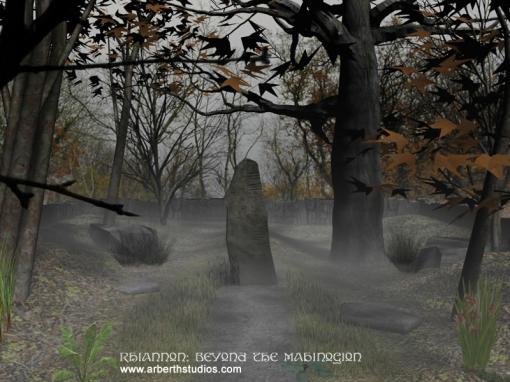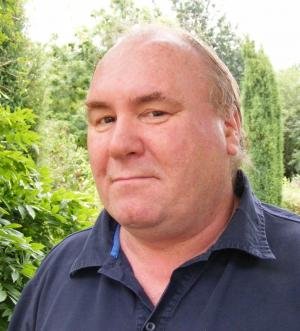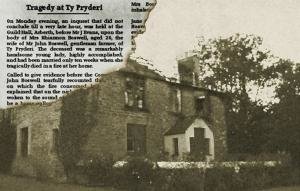Noel Bruton - Rhiannon: Curse of the Four Branches interview

In this genre, you just never know where the next horror might be lurking. In recent years, adventure fans have been treated to haunting stories from all over the world, from the U.S. to England, from Argentina to Turkey. Not to be outdone, now a small team from Wales jumps into the fray with Rhiannon: Curse of the Four Branches. Based on the collection of historical legends in the Mabinogion, the debut offering from Arberth Studios is a modern day tale set in the remote Welsh farmstead of Ty Pryderi, home to an ancient rivalry between the prince Pryderi and the evil wizard Llwyd that has carried on even centuries after death. Now the "House of Pryderi" threatens to claim a new victim, a teenaged girl named Rhiannon Sullivan. For her own well-being, Rhiannon's parents removed her from the house after she began having disturbing ghostly experiences, but her absence only delays the inevitable destiny that awaits her, and so players will need to delve the depths of the paranormal mystery surrounding the house.
A new haunted house tale set against the backdrop of Celtic legend should have many fans anxiously awaiting its release this fall. In the meantime, we did a little probing of our own, going behind the scenes with Arberth's co-founder Noel Bruton to discuss the game and the upstart development team behind it.

Adventure Gamers: So, just a few short months from the release of Rhiannon. Exciting times, or scary? Or maybe a combination of both?
Noel Bruton: These are great days. We’ve been working on this for just over two years, part time. This year, with the launch fast approaching, the coding is a 14-hour day, every day and has been that way since mid February, so you could add ‘exhausting’ too! Fortunately, we had worked through the story and the plot pretty much in its entirety before we started heavily into production, so really it was a matter of implementing what we had already designed. As we got closer to the beta test, we were getting ever faster at completing scenes, and the snags became ever fewer and easier to overcome – so the light at the end of the tunnel is exceedingly bright. We’re encouraged by the positive things people on the forums say about what they’ve seen of the game, and by the enthusiasm of the US publisher, Got Game Entertainment. It’s a bit scary too of course – will they like it?
AG: Before we delve too deeply into the game, let's get a bit better acquainted with its first-time developers. Who is Arberth Studios?
NB: There are three of us. Karen, whose idea all this was in the first place; Karen’s brother Richard, a designer and graphic illustrator by profession; and Noel (that’s me), Karen’s husband, who is turning his years in IT in this weird new direction. Karen and I live on a Welsh farmstead. Parts of our home bear a striking resemblance to Ty Pryderi, the fictional setting for Rhiannon – that’s Richard’s doing. A stream runs through our garden, called the ‘Nant Arberth’. I suppose you could say we took the name of the company from there, but that’s not the whole truth. In the Mabinogion, lord Pryderi had his seat at somewhere called ‘Glan Arberth’. We live in an area of Wales where part of the Mabinogion is said to have taken place.
AG: This is your first game as a team, but did you have any experience as developers individually before Rhiannon?
 |
Noel Bruton |
NB: No, none at all. I had done a bit of programming, but only as a hobby. I had a novel published a few years ago, so not unused to writing fiction. Richard models rooms and landscapes for a living, so it’s not too much of a technical departure for him, but he relishes the creative freedom that he gets from Rhiannon rather than just illustrating an architect’s ideas. Karen’s always had a thing about detailed research and she’s turned that to good use in Rhiannon, along with her years of gaming experience.
AG: At what point did you decide you were ready to tackle a full-fledged commercial adventure?
NB: Pretty much the day Karen finished playing Barrow Hill. “We could do this”, she said to me. “We’d get Richard to do the graphics and you could write the code”. I went looking for tools – I’d never heard of a ‘game engine’ until then – but I remember feeling even then that she was probably right. We’ve since been amazed many times at how between the three of us, we have a peculiar mix of skills that suits writing an adventure game. We never thought for a moment that we’d do it on any other scale than to go for a fully-fledged commercial product. There were a couple of hiccoughs – the first engine we tried, it took us a while to realize it couldn’t do everything we needed, and then Vista came along and that knocked us back a bit.
AG: Well, that more or less answers my next question. I was about to ask if it would be safe in assuming that you were inspired by the (relative) success of other indie horror adventures like Dark Fall, Scratches, and Barrow Hill.
NB: If we wore caps, we’d doff them in the direction of Jonathan Boakes. Karen had already played both Dark Falls and loved them, but it was Barrow Hill that got us started as developers and then Nucleosys’s Scratches firmed the idea up. It’s odd you should mention those titles – they really are the main ones that made us start writing.
AG: Are you longtime adventure fans, or did the genre simply fit the story you wanted to tell and the best format for telling it?
NB: Karen is the adventure gamer. She bought a Sinclair Spectrum in 1982 to play text-only adventures. When she and I bought our first 386 in the early 1990s, we specced it for The 7th Guest. She has crates of adventure games she’s played. Richard is not a gamer, but we’re trying to convert him. I would play an adventure game if Karen recommended it. As the ‘adventure’ genre is really the one Karen wants to play, so that was the one she wanted to create. She had a shortlist of the sort of elements she wanted to see in the game, in terms of story, challenges, scope, player interface and gameplay.
Adventure Gamers: Rhiannon is grounded in stories from the collection of Welsh historical legends called the Mabinogion, and the Four Branches in particular. What can you tell us about the cultural significance of these tales?
 |
Karen Bruton |
Noel Bruton: Karen and I live in the Welsh-speaking part of Wales and there the kids learn about the Mabinogion in school. There are plays and songs dedicated to it. It’s all over the tourist shops of course in many forms. There is a distinct deference to its significance in Welsh culture. The Mabinogion is to Wales as the Arthurian legends are to England. We have been mindful throughout that we three are English people making use of a Welsh icon and that as such, we should treat it with utmost respect.
AG: Why did you choose the Four Branches as the basis for your game?
NB: We thought we could use the Mabinogion, because if you strip it back, the Four Branches – four tales at the heart of the Mabinogion collection of legends - can be seen as four ages of man, which leads nicely to a chapter structure. There’s a lot going on in the stories as well, oodles of symbolism that would translate nicely into a computer game. It also appeared that it had never been used for a PC adventure. We extrapolated for the sake of story how the legends may still be having an effect on the present. The Four Branches gave us a protagonist, antagonist and collateral victims. Then we added an environment for it to take place in and plotted in characters who had encountered the hauntings before the player gets there.
AG: How integral is this literary foundation to the events of the game?
NB: I’ve got to be careful here. It’s a lot more than a backdrop. We use the symbols in the Mabinogion so closely that if I were to tell you their relationship to the story, I’d spoil the plot.
AG: So will those not familiar with the Mabinogion be at any disadvantage coming into the game?
NB: If the player has never heard of the Mabinogion, no worries. The game has its own identity. There are useful synopses to guide the player though the significance of the Mabinogion, where it matters to gaming. And if you want to read a slightly more detailed synopsis, take a look at the bookshelves in Malcolm Sullivan’s study.
AG: The game's subtitle has already been changed from ‘Beyond the Mabinogion’ to ‘Curse of the Four Branches’, undoubtedly to ward off the many "Beyond the WHAT??'s" sure to have met the former. Is there any concern for you that people outside Wales won't have the same level of interest in the game due to an unfamiliarity with the subject matter?
NB: I doubt that unfamiliarity itself will exclude players. Adventure gamers are curious by nature, they like intrigue and mystery. We’re hopeful that if the promise of a good game is sound enough, the unfamiliarity is more likely to attract than exclude because explorers thrive on what they don’t know. I think that’s why so many adventure games have intrigue built into the title. Unfamiliar words and mysterious titles are all over the adventure genre.
AG: The early story outline (and the game's title, obviously) center around a teenaged girl named Rhiannon, who experiences a traumatic, haunting experience after moving into an ancient rural Welsh farmstead. And yet in the game, Rhiannon's parents have taken her away and the central figure is historian and mythologist Jon Southworth. Is this really Jon's story or Rhiannon's, or a little of both? And who exactly is the player in Rhiannon?
 NB: You play yourself in the first-person, although we've given you a name – Chris – because the game needs a way to address you in messages you'll get as you play. You’ll encounter Jon Southworth and he’ll provide you with guidance, tools, hints and backstory. He thinks he’s communicating with Rhiannon about events at a place hundreds of miles from where he is. But he’s more wrapped up in this than he knows, which you will reveal. And it is not about Rhiannon as such – her work is done by the time the player gets there – it’s more about the significance of Rhiannon in the mind of our villain, Llwyd , and where she fits into the history of Ty Pryderi. The player will come to understand the importance of Rhiannon and use that to defeat Llwyd.
NB: You play yourself in the first-person, although we've given you a name – Chris – because the game needs a way to address you in messages you'll get as you play. You’ll encounter Jon Southworth and he’ll provide you with guidance, tools, hints and backstory. He thinks he’s communicating with Rhiannon about events at a place hundreds of miles from where he is. But he’s more wrapped up in this than he knows, which you will reveal. And it is not about Rhiannon as such – her work is done by the time the player gets there – it’s more about the significance of Rhiannon in the mind of our villain, Llwyd , and where she fits into the history of Ty Pryderi. The player will come to understand the importance of Rhiannon and use that to defeat Llwyd.
AG: The house is named Ty Pryderi, or the "House of Pryderi", who is a character featured in the Four Branches. Can you explain what relevance Pryderi has to the game's story, without giving away too much?
NB: In the Four Branches legends, Pryderi and his family make an enemy out of a devious and psychopathic sorcerer, Llwyd Cil Coed (pronounced HL-oo-id-Kill-Koyd). Throughout the Four Branches – and so throughout Pryderi’s life – these two come up against one another and some of the exchanges are pretty nasty. But they reach a kind of stalemate. So we extrapolated, what if that battle went on beyond the events described in the Mabinogion (hence the original working title), yet could be resolved by understanding it? What if Llwyd, having been forced to swear not to take his revenge during Pryderi’s life, sticks to the letter but not the spirit of that undertaking and takes his revenge in the afterlife instead? What form would that revenge take? And how might it be unraveled? The story of our game is how you go about understanding what Llwyd has done, and turning his intent back on him to undo it. But how do you defeat the afterlife? The clue is in the four ages of Pryderi's life, as they are described in the Four Branches of the Mabinogion. Don't worry – you don't have to read the Mabinogion to play this game!
Adventure Gamers: Any time the words "haunted house" are mentioned, people automatically equate the image with "horror". Would you describe Rhiannon as a horror game, or is it more of a suspenseful mystery?
Noel Bruton: There is no gore and no real violence in Rhiannon. But you are being haunted and you will be reminded of that regularly, and even more so as you resolve significant challenges. Is it horror? I like the term Jonathan Boakes uses, a “supernatural adventure”. With your feet firmly on the ground in a farmstead in present-day Wales, you take on a number of metaphysical and intellectual challenges. And yes, on occasion something will suddenly go “Boo”, and at others you’ll be aware of a nebulous mocking. Llwyd has killed people and is jeopardizing you, there’s no getting away from that. One player has referred to it as “a good game to play at night”, and another called it “seriously creepy”. But purely from a gameplay point of view, you can’t “die” in Rhiannon.
AG: Every culture has its own myths, but there seems to be such an enduring fascination with Celtic legends that manifests itself in a wealth of modern day ghost stories. Why do you think that is?
 NB: The thing about the Celtic myths is they are so many and varied. The Celts are truly amazing, starting in Eastern Europe and eventually populating the damp edges of Europe where they resisted the Moors, Saxons, Romans, Vikings and others, while building the sort of non-warlike economy that made their wealth of such interest to those invaders. They have all these stories coming from a long history and the many places they settled. All legends have odd things going on in them, but some of the stuff happening in the Mabinogion is simply outrageous. I feel the Celtic myths are attractive because they are indisputably old and such great stories.
NB: The thing about the Celtic myths is they are so many and varied. The Celts are truly amazing, starting in Eastern Europe and eventually populating the damp edges of Europe where they resisted the Moors, Saxons, Romans, Vikings and others, while building the sort of non-warlike economy that made their wealth of such interest to those invaders. They have all these stories coming from a long history and the many places they settled. All legends have odd things going on in them, but some of the stuff happening in the Mabinogion is simply outrageous. I feel the Celtic myths are attractive because they are indisputably old and such great stories.
AG: Do you personally believe in ghosts or paranormal phenomena?
NB: Do I “believe” in the paranormal? Tricky question. If we “believe” in it, then we risk exhibiting an irrational faith. If we don’t “believe” in it, then we arrogantly ignore everyday apparent anomalies that suggest the world is not as cut and dried as ‘conventional wisdom’ would have it. The problem is in how the word 'believe' has come to be used, and the quasi-religious overtones it carries. Yes, I personally have observed phenomena that would belie rationale, but then, I suppose, so has every quantum physicist. Weird, nonsensical stuff is part of life. We only have to observe it without pigeonholing it or distorting it with dogma. It can be quite an eye-opener.
AG: The focus here has been on the story and background of Rhiannon, but of course it's the gameplay that really makes or breaks an adventure. What can we expect from Rhiannon along those lines?
NB: There are no ‘minigames’ as such. There are a couple of order-based puzzles, but most of the challenges are based firmly around the plot and the inventory. As to puzzle difficulty, there are a couple of simple, almost mundane ones to get you started – but they are there only to reveal bigger challenges. You have to understand what motivates Llwyd to defeat him. You’ll be using a mixture of technology and magick, because it is magick that has created the situation at Ty Pryderi. You will have to think laterally. There is a poster on the wall in one of the rooms, saying “The Symbol’s the Thing”, to remind you not to take things too literally, because you’re dealing with magick and archetypes. The use of archetypes and symbols means that often your assumptions may have to be put aside – take the old glove you find in Chapter Two. It is an old glove – but it means something else.
The game is entirely first-person. There are no conversations, although there are a few voice-overs. There’ll be some reading to do, because you’ll need to understand the situation. Nobody ever tells you “you can’t do that here.” You can’t pick up an item ‘just in case’ you’ll need it. You can examine objects throughout the game but they won’t go to inventory until you have witnessed somewhere you could make use of them. It’s strictly point-and-click and using usually left mouse button, but also right when there are two ways to use an item. The challenges come from finding and combining objects, intellectually surmounting things that get in your way. One of the first things you will discover in each chapter is a suggestion of what you are up against at this phase of the game. Understanding that gives you your objectives for that chapter. But Llwyd and practicality will get in your way.
AG: What else would you say really defines Rhiannon that will set it apart and make it memorable?
NB: Most definitely a woman leading the project – it’s given the gameplay a certain flavour. It deliberately contains all the features Karen most likes in an adventure game. Point-and-click, no dying, first-person, music only when it means something, no long dialogue, figure the game out by yourself without asking in-game characters, logical challenges that would really make sense, you can’t clog your inventory with stuff you can’t use, a BIG inventory, identifiable plot and puzzle themes, no sliders.
 |
Richard Lee |
The blokes had their say too – for example, Richard and I had great fun imagining to what uses an Edwardian engineering industrialist and a hippie commune would have put Ty Pryderi.
A tale spanning four eras over the past thousand years, each with their own significance and contribution to the plot. Theme-based music with proper tunes - a ‘soundtrack’ approach to the music some may find unusual. No loose ends in the parallel plot themes. The discovery that in this game, Rhiannon is not just the name of a teenage girl. A classic ‘ages of life’ story arc, and though we say it ourselves, a very satisfying finale.
AG: I’m sure that list will come as welcome news to a great many gamers. You're currently shooting for a Halloween release. That must mean you're making good progress. Where are you with the game at this point?
NB: We have recruited a number of volunteer beta testers around the world and they started work in early August, playing a virtually complete working version of the game. We’ll still be making improvements while that is going on, finalizing the music and tweaking some of the graphics and sound effects.
AG: Well, since you're facing crunch time, you don't need us holding you up any longer. But we do appreciate your time, and we're looking forward to the finished results in a few months.













